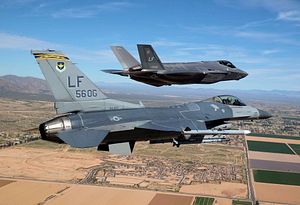The United States Air Force, Navy and Marine Corps are planning to acquire a total of 2,457 F-35 fighter jets with operation and maintenance costs estimated as high as $1,016 billion over the next four decades, according to the Office of the U.S. Secretary of Defense.
The 5th generation stealthy multirole aircraft is primarily designed for ground attack, aerial reconnaissance, and air defense missions rather than air combat. Yet, the plane obviously should still have the capacity to successfully defend itself against enemy air superiority fighters (In fact, some countries interested in procuring the F-35 want to deploy it first and foremost in an air-superiority role).
However, according to a report obtained by War is Boring, defending itself against legacy 4th generation air-superiority fighters is perhaps too tall of an order for the F-35. A five-page report by a test pilot of an aerial combat exercise over the Pacific Ocean near Edwards Air Force Base in California in January 2015 notes that the F-35 could not beat the F-16 in a close-range dogfight (aka “visual range air-to-air engagement tests”).
“The F-35 was at a distinct energy disadvantage,” the pilot emphasized in the report noting that the only way to successfully engage the F-16 was by executing a specific maneuver:
Once established at high AoA, a prolonged full rudder input generated a fast enough yaw rate to create excessive heading crossing angles with opportunities to point for missile shots.
Yet, the disadvantage of this rudder reversal maneuver is that it usually only works once:
The technique required a commitment to lose energy and was a temporary opportunity prior to needing to regain energy … and ultimately end up defensive again.
As one analyst over at Foxtrot Alpha succinctly summarizes: “In dogfighting, energy is everything, and if your enemy has more kinetic and potential energy for maneuvers than you do, then you’re toast.”
Attempting to attack the F-16 with the F-35’s 25mm cannon also failed. The pilot notes: “Instead of catching the bandit off-guard by rapidly pull aft to achieve lead, the nose rate was slow, allowing him to easily time his jink prior to a gun solution.” Nevertheless, when the F-16 took over the role of the attacker the F-35 failed to evade the older fighter jet due to a “lack of nose rate.”
Additionally, it turned out that the pilot’s helmet was just too big to be of any use in a dogfight. According to the report: “The helmet was too large for the space inside the canopy to adequately see behind the aircraft.”
The specific planes used in the exercises were an older F-35 Joint Strike Fighter with the designation AF-02 and a two-seat F-16D Block 40. While the F-35 did not carry any weapons in its bomb bay, the F-16 carried two fuel tanks under its wings (see: “Oops, US Close-Air Support Bomb Doesn’t Fit on the F-35”).
Tyler Rogoway over at FoxTrot Alpha elaborates that “the aircraft flown in the test, an F-35A, is the most maneuverable F-35 variant of the lot, being capable of pulling 9g, while the carrier capable F-35C is capable of pulling 7.5g and the short takeoff and vertical landing variant, the F-35B, is only capable of pulling 7g.”
Aviation Week reported on the same or similar air-to-air combat maneuvers involving a F-16D Block 40 and an F-35 with an AF-02 designation. The article quotes the F-35 program director Col. Rod Cregier, who explained the simulated dogfights in more neutral terms noting that the simulation was primarily designed to see “how it [F-35]would look like against an F-16 in the airspace. It was an early look at any control laws that may need to be tweaked to enable it to fly better in future. You can definitely tweak it—that’s the option.”
In addition, an analyst at fightersweep.com points out that we should not over-interpret the results of a single visual range air-to-air engagement test:
This aircraft is still in its infancy. Tactics, techniques, and procedures that key on strengths and minimize weaknesses are just starting to be developed. Taking one report and proclaiming that the F-35 is a piece of FOD in the air-to-air arena is irresponsible and sensationalist at best. There are far too many other factors to look at.

































